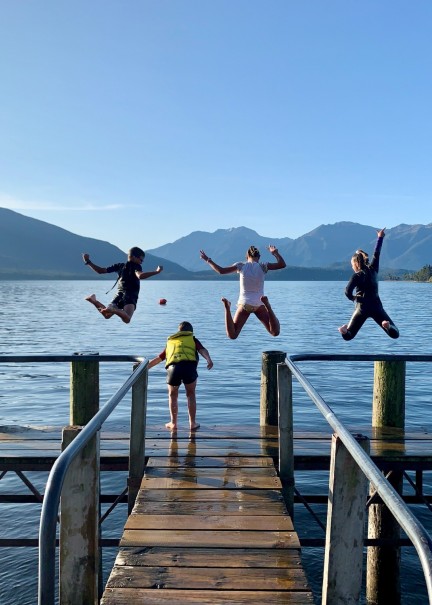Fiordland - People & Culture
A PIONEERING SPIRIT
Today, Te Anau is a bustling town where tourism, conservation, farming, crayfishing and a venison industry co-exist. There was a time when Te Anau was predominantly a rural town with tourism playing a minor role. With some of New Zealand's most revered natural icons on the doorstep, the community today is driven by increasing visitor numbers with the farming and fishing industries working alongside.
The population of around 3,000 permanent residents in Te Anau enjoys a quieter lifestyle but don’t miss out on much thanks to the proximity of Queenstown to the north and Invercargill to the south. Shopping, airports and other services are just a two-hour drive away.
To live here, is to enjoy one of New Zealand’s most spectacular pieces of natural wilderness as your backyard. It fosters a sense of appreciation that is often lost in big cities. From kindergarten through to high school, local children are immersed in the environment as part of their education.
Fiordland became the scene of one of New Zealand's most significant conservation debates when in the 1960s it was proposed to raise the level of Lake Manapouri to assist hydro-electricity production at West Arm. The ensuing battle resulted in the government ultimately bowing to the weight of people power and petitions, and passed a bill in the 1970s giving the lake statutory protection. Lake Manapouri was subsequently ‘saved’ with the power station at West Arm now operating under strict controls.
Early People
Before roads, tracks and huts, Māori traversed the mountains and coastlines of Fiordland in search of pounamu / greenstone. While there is little physical evidence of permanent settlements here, the spiritual and mythological significance of the area hold great value for tangata whenua (people of the land). Today, Ngäi Tahu (the overarching iwi / tribal authority for tangata whenua) are actively involved in the management of the land.
Fiordland and the Southern Alps were sighted by such prominent European explorers as Abel Tasman and Captain Cook who charted the coastline of the western corner of New Zealand’s South Island in the late eighteenth century. In their mighty sailing ships, explorers were hesitant to enter the fiords, unsure of what lay beyond the steep walls. Captain Cook sailed past Milford Sound on two of his voyages believing it to be a shallow bay.
Had they ventured here, they would have found a magnificent, mountainous area of unparalleled beauty as their Māori predecessors had. An area boasting not only stunning snow-capped summits, lush bush forests, and the extraordinary sight of the glaciers, but also an unimaginable population of birdlife and their deafening birdsong.
In 1773, Captain Cook spent five weeks in Dusky Sound. Cook's maps and descriptions soon attracted sealers and whalers who founded the first European settlements of New Zealand.
Early settlers
From the middle of the 19th century, surveyors, explorers and prospectors began to penetrate the unexplored interior of Fiordland. Preservation Inlet boomed briefly in the 1890s after gold was found, but efforts to establish mines, timber mills and farms in Fiordland were generally short-lived. The dense native bush and the challenging weather of Fiordland were what ultimately saved it from the logging and development of the day.
It was the early pioneers of tourism who were able to meet the challenge of Fiordland’s tough mountain passes and dense bush to eventually open up small sections of the area for commercial ventures.
By the late 19th century, Quintin McKinnon was the first European to establish tracks into the challenging depths of Fiordland. Mackinnon Pass would go on to become the Milford Track, one of the world’s finest walks. By 1889, Quintin McKinnon and Donald Sutherland were guiding tourists along the Milford Track and stories about the spectacular beauty of Piopiotahi / Milford Sound were spreading internationally. Sutherland lived in Milford Sound for 40 years and his name is now part of local folklore.
Another ‘first’ occurred in 1935 when the ambitious Henry Homer first contemplated the notion of building a tunnel through the Darran Mountain ranges to create a road to Piopioptahi / Milford Sound. It took a further 19 years to complete the project which involved drilling and digging through the tough granite rock. When the tunnel breakthrough was finally made, Homer had established the first and only road link into Piopiotahi / Milford Sound.
For the pioneers who shaped the history of tourism in Fiordland, there was much hard work to do and the challenges of geology to overcome. Despite this, they persevered, and it is thanks to their enthusiasm and tenacity that places like Piopiotahi / Milford Sound are now accessible to visitors from around the world.
Deer recovery began as a way to combat the large numbers of introduced deer causing destruction within Fiordland National Park. Intrepid entrepreneurs started using helicopters to shoot or live capture deer rather than relying on the less efficient method of solo hunters. Live deer were captured and brought back to Te Anau and Manapouri to kick start a deer farming industry. The deer recovery days were in some ways, Fiordland’s gold-rush. And while there was a big reward, there was also a big risk. A common method involved a hunter leaping from the helicopter to live capture deer in nets while a cool-headed pilot hovered above.
